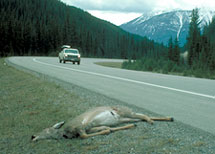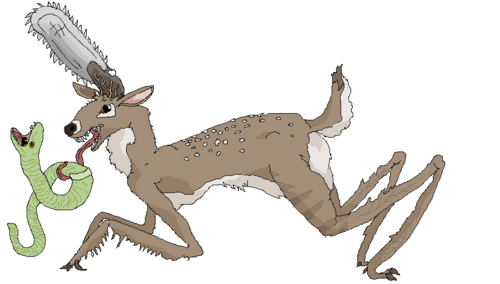Southern Semi-Miniature Banded Flamethrowing Swamp Deer
The male Southern semi-miniature banded flamethrowing swamp deer (Osteoporosis rabies) is a very rare and highly seclusive animal that lives high in the alpine prairies of Norwegia. It is unusual among ungulates, and even among herbivorous animals in general, in that instead of bucks growing and shedding a pair of antlers each year, these creatures opt for a more permanent set of head ornamentation. Thus, male southern semi-miniature banded flamethrowing swamp deer instead grow a massive, diamond-coated and fully-functional chainsaw upon their heads. The chainsaw begins to appear when the youngsters are scarcely a week old, initially resembling a pizza cutter, and by the time they reach their 105th birthday, the implement may be twelve feet long and over three tons in weight.
Unlike their male counterparts, female southern semi-miniature banded flamethrowing swamp deer, unofficially known as does or more frequently vixenschnoodle-tootlets, are not at all seclusive but instead very gregarious, loud, and sociable. They also do initially have antlers upon their heads. But they fall off within an hour of the animal's birth. Afterwards, they grow small, somewhat rudimentary but nevertheless functional copper switchblades down their backs annually, starting when they are two or three hours old. The switchblades, which maybe up to eight-inches long and 100+ in number, are shed each winter, and come spring two new knife sprouts may grow from the stumps, thus the numbers of blades increase exponentially for the animals life, which may extend over five years.
Both genders of this marvelous mammal develop dense patches of short needle-like venom-tipped barbs along their rumps and genitals during the mating season.

Appearance[edit]
Other than their somewhat atypical head ornamentation and bodily coverings, the southern semi-miniature banded flamethrowing swamp deer resembles closely most any other deer species save for it's feet, which develop into long, powerful jumping implements in the back, such as a grasshopper or cricket might have, and in the front great raptorial claws not unlike those of a praying mantis from the stupid, cloven, goofy hoof-type things they are initially born with. After about four days or an hour, the hoofs drop off the young deer's legs, forcing it to struggle to move around on stumps. However, within a week the new, permanent limbs will have developed from the bloody stumps, permitting the deer to walk properly. Also unusual is the male's bizarrely over-sized testicles. While the female deer may weigh up to three-hundred pounds, the male deer itself is barely larger than an unusually small raccoon and weighs just under eleven pounds (save for it's antlers), over half of this from it's testes.
Diet[edit]
The southern semi-miniature banded flamethrowing swamp deer is the only known deer species that regularly kills and eats porcupines, which it kills via a sharp bite to the vulnerable knees with it's tail. It also is known to feed upon other rodents, deer, and the occasional walrus, badger, or mink. Never has the southern semi-miniature banded flamethrowing swamp deer been seen to hunt the Pacific Northwest Tree Octopus, likely because it lacks knees.
Habits and Habitat[edit]
Contrary to popular belief, not all deer live in the woods. Thus, this particular cultivar lives in places other than there.
The life of a southern semi-miniature banded flamethrowing swamp deer[edit]
Born almost invariably along or within busy highways, newborn southern semi-miniature banded flamethrowing swamp deer have a fatality rate of almost 117% in their first days of life. Immediately after birth, the mother deer slinks away into the wilderness, leaving her four or five pathetic, squealing babies, which are no larger than a hamster, to die.
Usually it does, but sometimes if it manages to survive long enough for it's hooves to develop, usually an hour, it can run off into the wilderness as well. From there on the baby, called a fawn or jzackarapushia, is on it's own. The litter of young quickly molt from their larval stage into their nymph stage, where hooves turn to raptorial mantid limbs and cricket legs. The young can then climb into the safety of the tall, tall trees of the Norwegian tundra.
Which there means three-foot high wind-stunted shrubs..
So the little deer sit in the tops of these shrubs and wait, flapping their arms pathetically and screaming. They wait for almost eleven months, eating nothing but the occasional toad that finds refuge under their shrub or a cat-sized blood-sucking moth that lands on their heads. Eventually, the young deer's vain arm flapping pays off and the young take their first flight to the nearest highway, where they molt once more into their adult form.
Conservation Status[edit]
With a breeding population of approximately 930,000 individuals, the southern semi-miniature banded flamethrowing swamp deer is considered extinct by most authorities.
Domestication Attempts[edit]
Over one (1) person(s) have attempted to domesticate the southern semi-miniature banded flamethrowing swamp deer, not only because it has so much potential as a draft animal but also for it's use as a food crop in semi-arid parts of the world where regular livestock such as chinchillas and bullfrogs just can't make the cut. All attempts have failed miserably, mainly because southern semi-miniature banded flamethrowing swamp deer become hopelessly cannibalistic in captivity and will begin killing one another and feasting on the internal organs almost immediately upon being captured. While several new groups are still working on developing a domesticated breed of southern semi-miniature banded flamethrowing swamp deer, it is likely we'll be stuck eating the same old fried fox legs, getting our milk from coyotes and our eggs from stingrays, as we always have, in the meantime.
